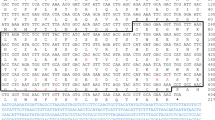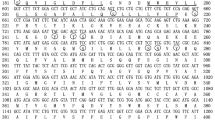Abstract
The cDNAs and genes of two different types of leucine-rich repeat-containing proteins from grass carp (Ctenopharyngodon idellus) were cloned. Homology search revealed that the two genes, designated as GC-GARP and GC-LRG, have 37% and 32% deduced amino-acid sequence similarities with human glycoprotein A repetitions predominant precursor (GARP) and leucine-rich α2-glycoprotein (LRG), respectively. The cDNAs of GC-GARP and GC-LRG encoded 664 and 339 amino acid residues, respectively. GC-GARP and GC-LRG contain many distinct structural and/or functional motifs of the leucine-rich repeat (LRR) subfamily, such as multiple conserved 11-residue segments with the consensus sequence LxxLxLxxN/CxL (x can be any amino acid). The genes GC-GARP and GC-LRG consist of two exons, with 4,782 bp and 2,119 bp in total length, respectively. The first exon of each gene contains a small 5′-untranslated region and partial open reading frame. The putative promoter region of GC-GARP was found to contain transcription factor binding sites for GATA-1, IRF4, Oct-1, IRF-7, IRF-1, AP1, GATA-box and NFAT, and the promoter region of GC-LRG for MYC-MAX, MEIS1, ISRE, IK3, HOXA9 and C/EBP alpha. Phylogenetic analysis showed that GC-GARP and mammalian GARPs were clustered into one branch, while GC-LRG and mammalian LRGs were in another branch. The GC-GARP gene was only detected in head kidney, and GC-LRG in the liver, spleen and heart in the copepod (Sinergasilus major)-infected grass carp, indicating the induction of gene expression by the parasite infection. The results obtained in the present study provide insight into the structure of fish LRR genes, and further study should be carried out to understand the importance of LRR proteins in host–pathogen interactions.








Similar content being viewed by others
References
Ayer DE, Eisenman RN (1993) A switch from Myc:Max to Mad: Max heterocomplexes accompanies monocyte/macrophage differentiation. Genes Dev 7:2110–2119
Calvo KR, Knoepfler PS, Sykes DB, Pasillas MP, Kamps MP (2001) Meis1a suppresses differentiation by G-CSF and promotes proliferation by SCF: potential mechanisms of cooperativity with Hoxa9 in myeloid leukemia. Proc Natl Acad Sci USA 98:13120–13125
Dumortier A, Kirstetter P, Kastner P, Chan S (2003) Ikaros regulates neutrophil differentiation. Blood 101:2219–26
Hirono I, Takami M, Miyata M, Miyazaki T, Han HJ, Takano T, Endo M, Aoki T (2004) Characterization of gene structure and expression of two toll-like receptors from Japanese flounder, Paralichthys olivaceus. Immunogenetics 56:38–46
Hortsch M, Goodman CS (1991) Cell and substrate adhesion molecules in Drosophila. Annu Rev Cell Biol 7:505–557
Kajava AV, Vassart G, Wodak SJ (1995) Modeling of the three-dimensional structure of proteins with the typical leucine-rich repeats. Structure 3:867–877
Kedzierski L, Montgomery J, Curtis J, Handman E (2004) Leucine-rich repeats in host-pathogen interactions. Arch Immunol Ther Exp (Warsz) 52:104–112
Kobe B, Deisenhofer J (1994) The leucine-rich repeat: a versatile binding motif. Trends Biochem Sci 19:415–421
Kobe B, Kajava AV (2001) The leucine-rich repeat as a protein recognition motif. Curr Opin Struct Biol 11:725–732
Li SF, Lu QQ, Zhou BY (1995) Evaluation on the potential capacity of the swan oxbow for the conservation of the major Chinese carps. Aquaculture 137:46–47
O’Donnell LC, Druhan LJ, Avalos BR (2002) Molecular characterization and expression analysis of leucine-rich alpha2-glycoprotein, a novel marker of granulocytic differentiation. J Leukoc Biol 72:478–485
Ollendorff V, Noguchi T, de Lapeyriere O, Birnbaum D (1994) The GARP gene encodes a new member of the family of leucine-rich repeat-containing proteins. Cell Growth Differ 5:213–219
Rock FL, Hardiman G, Timans JC, Kastelein RA, Bazan JF (1998) A family of human receptors structurally related to Drosophila Toll. Proc Natl Acad Sci USA 95:588–593
Takahashi N, Takahashi Y, Putnam FW (1985) Periodicity of leucine and tandem repetition of a 24-amino-acid segment in the primary structure of leucine-rich α2-glycoprotein of human serum. Proc Natl Acad Sci USA 82:1906–1910
Zhang DE, Zhang P, Wang ND, Hetherington CJ, Darlington GJ, Tenen DG (1997) Absence of granulocyte colony-stimulating factor signaling and neutrophil development in CCAAT enhancer binding protein alpha-deficient mice. Proc Natl Acad Sci USA 94:569–574
Acknowledgements
The authors are very grateful for valuable comments from an anonymous referee, which have significantly improved the publication. The research was supported by the National Natural Science Foundation of China through projects 300130150 and 30025035
Author information
Authors and Affiliations
Corresponding author
Additional information
The nucleotide sequence data reported in this paper will appear in the Genbank nucleotide sequence database with accession numbers AY663649, AY663650, AY663651 and AY663652.
Rights and permissions
About this article
Cite this article
Chang, M.X., Nie, P., Xie, H.X. et al. Characterization of two genes encoding leucine-rich repeat-containing proteins in grass carp Ctenopharyngodon idellus. Immunogenetics 56, 710–721 (2005). https://doi.org/10.1007/s00251-004-0737-3
Received:
Revised:
Published:
Issue Date:
DOI: https://doi.org/10.1007/s00251-004-0737-3




